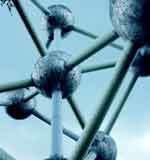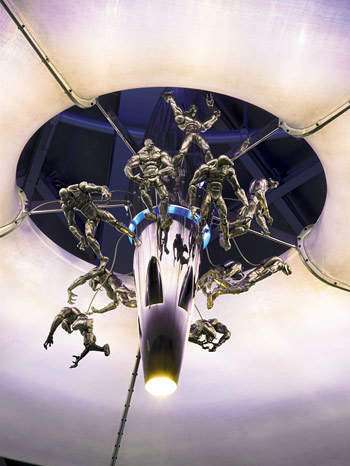As a symbol of Expo 58, the image of Belgium’s Atomium is known around the world. The Atomium was built in 1958 for the World’s Fair. Renovation of this landmark building, originally planned to last only six months, was undertaken in October 2004 and completed in 2006.
An aluminium and steel construction of 102m high, this landmark development is the dominant element on the plateau of the Heysel in Brussels. The design team have seen their creation last through decades and gain fame as Belgium’s answer to the Eiffel Tower. The architects of Atomium were André Waterkeyn and André and Jean Polak.
The Atomium celebrated its 50th anniversary in 2008.
Construction of the Atomium
The nine-sphere Atomium took 18 months to conceptualise and another 18 months to build.
The structure is coated with aluminium and weighs around 2.400t. Each sphere, which has a diameter of 18m, consists of an elevator that carries visitors to the upper sphere. The upper sphere provides a panoramic view of Heysel Park and the city of Brussels.
The Atomium’s nine-sphere structure
The Atomium building represents an iron crystal molecule, with each sphere symbolising individual atoms. The structure is also said to represent Belgium’s nine provinces, and was designed to bring harmony between the French and Flemish-speaking areas of the country.
During the modernisation, the existing skin was replaced with stainless steel outside and galvanised steel inside. The contemporary look of the new pavilion gives an extra dimension to the Atomium.
At the foot of the structure is an urban square from which visitors can admire the Atomium at various angles. At different positions throughout the complex, visitors can make use of a broad choice of urban furniture, and consider the contrasts between the foot of the building, the esplanade and the splendid view from the site.
The wind tunnel tests conducted on the structure proved that it would topple in winds of 80km per hour and above. Therefore, support columns were added to provide resistance.
Design of the spheres and tubes
The inner space of the Atomium passes continuously through the spheres and tubes. The design revolves around the ideas of emptying, opening, perceiving and experiencing. The Atomium takes visitors on a journey through its spheres, giving them a new aesthetic experience.
A visit to the Atomium begins in the bottom sphere, with an exhibition dedicated to Expo 58 and details of how the structure was first built. Next are the spheres for temporary exhibitions, which include artwork, photographs and film screenings. Visitors then proceed to the central sphere. While waiting for the lift, they can visit the venue’s two bars.
In the upper sphere, people can sample the restaurant menu and enjoy the splendid panorama created by the new windows.
While descending, the visitors’ route continues into the children’s sphere, which is a gateway to a dream world, with an overnight dormitory for visiting schoolchildren and is furnished with water molecules.
Six of the Atomium’s nine spheres are accessible, offering a journey of discovery and a diverse range of perspectives.





